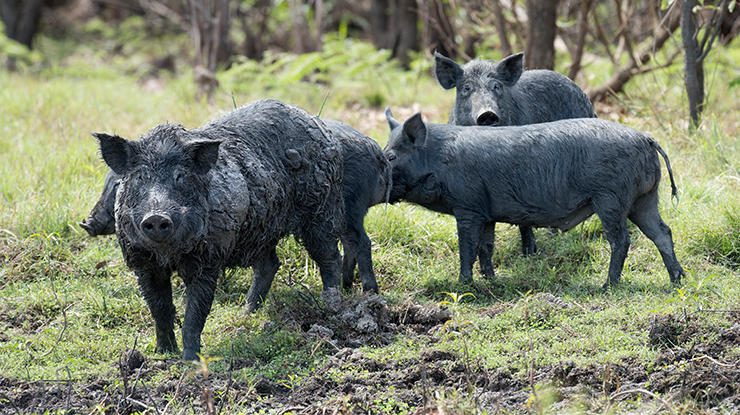It’s Feral Friday: pigs
24 October 2019

MLA continues to shine the spotlight on invasive animals that impact the livestock industry and the tools available to help manage them. So far we’ve covered wild dogs and rabbits. Feral pigs are the focus of this week’s article.
The threat of African Swine Fever (AFS) entering Australia reinforces the importance of managing feral pigs, to prevent the spread of this emergency animal disease. Read this factsheet from Australian Pork for more information on preventing the outbreak of ASF. MLA is involved in industry efforts to maintain Australia’s biosecurity and prevent emergency animal diseases and has developed this article about African Swine Fever and these tips for on-farm biosecurity.
MLA supported the former Invasive Animals CRC to ensure a coordinated, multi-species and ecosystems approach to ethical pest control. MLA has also directly supported the development of the PIGOUT® and HOGGONE® baits.
|
Fast facts
|
Impact
Feral pigs are estimated to cost the agricultural sector $14.4 million each year in lost production (based on 2013-14 livestock prices).
They are recognised as a key threat to native flora, fauna and ecosystems under federal legislation, and are a declared pest animal in Queensland, NSW, ACT, Victoria and WA.
Feral pigs cause agricultural damage by preying on newborn lambs, reducing crop yields, damaging fences and water sources, and competing with stock for feed by consuming or damaging pasture. They’re also considered a major threat to stock as a potential carrier of exotic diseases.
Industry action
The Invasive Animals CRC and Animal Control Technologies Australia, with support from MLA and other industry partners, developed the 1080 (sodium fluoroacetate) PIGOUT® bait, the next-generation sodium nitrite HOGGONE® bait, and the HogHopper™ feral pig-specific bait delivery device.
HOGGONE is currently undergoing assessment by the Australian Pesticides and Veterinary Medicines Authority (APVMA) as part of its registration application process. Download PestSmart’s Frequently Asked Questions about HOGGONE fact sheet for more information.
What can producers do?
Feral pigs are difficult to manage as they can breed back quickly and change their movement patterns and behaviour in response to control.
Effective control requires population reduction of at least 50% to 70% every year. Best practice management typically involves a combination of control techniques.
PestSmart’s Glovebox Guide for Managing Feral Pigs lists the pros and cons of currently available control tools and when to use each one.
The PestSmart website also contains detailed Standard Operating Procedures for control methods, including:
Use the FeralPigScan website and app to record and map sightings of feral pigs, and to support collaborative and coordinated control efforts: feralscan.org.au/feralpigscan/
Limits to control
Feral pig management is a state jurisdiction matter, so landholder responsibilities and the tools available to them differ depending on where control is being carried out. Check with your local producer group and/or state department before starting a control program.
Useful links
PestSmart Glovebox Guide for Managing Feral Pigs


